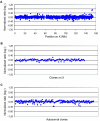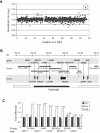Duplication of the MECP2 region is a frequent cause of severe mental retardation and progressive neurological symptoms in males
- PMID: 16080119
- PMCID: PMC1226209
- DOI: 10.1086/444549
Duplication of the MECP2 region is a frequent cause of severe mental retardation and progressive neurological symptoms in males
Abstract
Loss-of-function mutations of the MECP2 gene at Xq28 are associated with Rett syndrome in females and with syndromic and nonsyndromic forms of mental retardation (MR) in males. By array comparative genomic hybridization (array-CGH), we identified a small duplication at Xq28 in a large family with a severe form of MR associated with progressive spasticity. Screening by real-time quantitation of 17 additional patients with MR who have similar phenotypes revealed three more duplications. The duplications in the four patients vary in size from 0.4 to 0.8 Mb and harbor several genes, which, for each duplication, include the MR-related L1CAM and MECP2 genes. The proximal breakpoints are located within a 250-kb region centromeric of L1CAM, whereas the distal breakpoints are located in a 300-kb interval telomeric of MECP2. The precise size and location of each duplication is different in the four patients. The duplications segregate with the disease in the families, and asymptomatic carrier females show complete skewing of X inactivation. Comparison of the clinical features in these patients and in a previously reported patient enables refinement of the genotype-phenotype correlation and strongly suggests that increased dosage of MECP2 results in the MR phenotype. Our findings demonstrate that, in humans, not only impaired or abolished gene function but also increased MeCP2 dosage causes a distinct phenotype. Moreover, duplication of the MECP2 region occurs frequently in male patients with a severe form of MR, which justifies quantitative screening of MECP2 in this group of patients.
Figures






Similar articles
-
Recurrent infections, hypotonia, and mental retardation caused by duplication of MECP2 and adjacent region in Xq28.Pediatrics. 2006 Dec;118(6):e1687-95. doi: 10.1542/peds.2006-0395. Epub 2006 Nov 6. Pediatrics. 2006. PMID: 17088400
-
Chromosome Xq28 duplication encompassing MECP2: Clinical and molecular analysis of 16 new patients from 10 families in China.Eur J Med Genet. 2016 Jun;59(6-7):347-53. doi: 10.1016/j.ejmg.2016.05.004. Epub 2016 May 11. Eur J Med Genet. 2016. PMID: 27180140
-
Xq28 duplications including MECP2 in five females: Expanding the phenotype to severe mental retardation.Eur J Med Genet. 2012 Jun;55(6-7):404-13. doi: 10.1016/j.ejmg.2012.02.009. Epub 2012 Mar 29. Eur J Med Genet. 2012. PMID: 22522176 Free PMC article.
-
Distal Xq duplication and functional Xq disomy.Orphanet J Rare Dis. 2009 Feb 20;4:4. doi: 10.1186/1750-1172-4-4. Orphanet J Rare Dis. 2009. PMID: 19232094 Free PMC article. Review.
-
[Advance in research on MECP2 [corrected] duplication syndrome].Zhonghua Yi Xue Yi Chuan Xue Za Zhi. 2015 Jun;32(3):426-9. doi: 10.3760/cma.j.issn.1003-9406.2015.03.028. Zhonghua Yi Xue Yi Chuan Xue Za Zhi. 2015. PMID: 26037367 Review. Chinese.
Cited by
-
The chromatin tapestry as a framework for neurodevelopment.Genome Res. 2024 Oct 29;34(10):1477-1486. doi: 10.1101/gr.278408.123. Genome Res. 2024. PMID: 39472026 Free PMC article. Review.
-
Drosophila as a model for MECP2 gain of function in neurons.PLoS One. 2012;7(2):e31835. doi: 10.1371/journal.pone.0031835. Epub 2012 Feb 21. PLoS One. 2012. PMID: 22363746 Free PMC article.
-
Xp11.2 microduplications including IQSEC2, TSPYL2 and KDM5C genes in patients with neurodevelopmental disorders.Eur J Hum Genet. 2016 Mar;24(3):373-80. doi: 10.1038/ejhg.2015.123. Epub 2015 Jun 10. Eur J Hum Genet. 2016. PMID: 26059843 Free PMC article.
-
Genetic syndromes caused by mutations in epigenetic genes.Hum Genet. 2013 Apr;132(4):359-83. doi: 10.1007/s00439-013-1271-x. Epub 2013 Jan 31. Hum Genet. 2013. PMID: 23370504 Review.
-
Partial rescue of MeCP2 deficiency by postnatal activation of MeCP2.Proc Natl Acad Sci U S A. 2007 Feb 6;104(6):1931-6. doi: 10.1073/pnas.0610593104. Epub 2007 Jan 31. Proc Natl Acad Sci U S A. 2007. PMID: 17267601 Free PMC article.
References
Web Resources
-
- Ensembl Genome Browser, http://www.ensembl.org/Homo_sapiens/
-
- Online Mendelian Inheritance in Man (OMIM), http://www.ncbi.nlm.nih.gov/Omim/ (for MECP2 and L1CAM and Rett, HSAS, MASA, and CRASH syndromes)
-
- UCSC Human Genome Browser, http://genome.ucsc.edu/cgi-bin/hgGateway?org=Human
References
-
- Akiyama M, Kawame H, Ohashi H, Tohma T, Ohta H, Shishikura A, Miyata I, Usui N, Eto Y (2001) Functional disomy for Xq26.3-qter in a boy with an unbalanced t(X;21)(q26.3;p11.2) translocation. Am J Med Genet 99:111–114 - PubMed
-
- Amir RE, Van den Veyver IB, Wan M, Tran CQ, Francke U, Zoghbi HY (1999) Rett syndrome is caused by mutations in X-linked MECP2, encoding methyl-CpG-binding protein 2. Nat Genet 23:185–188 - PubMed
-
- Amir RE, Zoghbi HY (2000) Rett syndrome: methyl-CpG-binding protein 2 mutations and phenotype-genotype correlations. Am J Med Genet 97:147–152 - PubMed
-
- Ariani F, Mari F, Pescucci C, Longo I, Bruttini M, Meloni I, Hayek G, Rocchi R, Zappella M, Renieri A (2004) Real-time quantitative PCR as a routine method for screening large rearrangements in Rett syndrome: report of one case of MECP2 deletion and one case of MECP2 duplication. Hum Mutat 24:172–177 - PubMed
Publication types
MeSH terms
Substances
LinkOut - more resources
Full Text Sources
Other Literature Sources
Medical
Molecular Biology Databases
Miscellaneous

